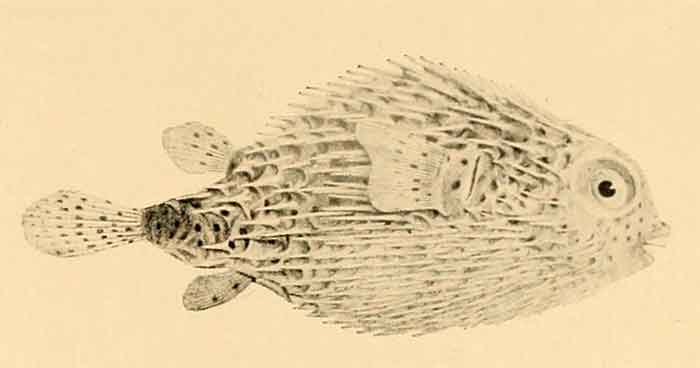Superregnum: Eukaryota
Cladus: Unikonta
Cladus: Opisthokonta
Cladus: Holozoa
Regnum: Animalia
Subregnum: Eumetazoa
Cladus: Bilateria
Cladus: Nephrozoa
Superphylum: Deuterostomia
Phylum: Chordata
Subphylum: Vertebrata
Infraphylum: Gnathostomata
Megaclassis: Osteichthyes
Superclassis/Classis: Actinopterygii
Classis/Subclassis: Actinopteri
Subclassis/Infraclassis: Neopterygii
Infraclassis: Teleostei
Megacohors: Osteoglossocephalai
Supercohors: Clupeocephala
Cohors: Euteleosteomorpha
Subcohors: Neoteleostei
Infracohors: Eurypterygia
Sectio: Ctenosquamata
Subsectio: Acanthomorphata
Divisio/Superordo: Acanthopterygii
Subdivisio: Percomorphaceae
Series: Eupercaria
Ordo: Tetraodontiformes
Subordo: Tetraodontoidei
Familia: Diodontidae
Genus: Diodon
Species (5): D. eydouxii – D. holocanthus – D. hystrix – D. liturosus – D. nicthemerus
nomen dubium: D. raninus
Name
Diodon Linnaeus, 1758
Gender: masculine
Type species: Diodon hystrix Linnaeus, 1758
References
Linnaeus, C. 1758. Systema Naturae per regna tria naturæ, secundum classes, ordines, genera, species, cum characteribus, differentiis, synonymis, locis, Tomus I. Editio decima, reformata. Holmiæ: impensis direct. Laurentii Salvii. i–ii, 1–824 pp DOI: 10.5962/bhl.title.542: 334. Open access Reference page.
Diodon in the World Register of Marine Species
Diodon and its species (including synonyms) in Catalog of Fishes, Eschmeyer, W.N., Fricke, R. & van der Laan, R. (eds.) 2024. Catalog of Fishes electronic version.
Vernacular names
English: Spiny balloonfish
ไทย: ปลาปักเป้าหนามทุเรียน

Diodon hystrix
Porcupinefishes or balloonfishes, are any of the various species of the genus Diodon, the type genus of Diodontidae.
Distinguishing features
Fish of the genus Diodon have:
two-rooted, movable spines (which are derived from modified scales) distributed over their bodies.
beak-like jaws, used to crush their hard-shelled prey (crustaceans and molluscs).[2]
They differ from the swelltoads and burrfishes (genera Cyclichthys and Chilomycterus, respectively), which, in contrast, have fixed, rigid spines.
Defense mechanisms
Like true pufferfishes of the related family Tetraodontidae, porcupinefishes can inflate themselves. Once inflated, a porcupinefish's erected spines stand perpendicular to the skin, whereupon they then pose a major difficulty to their predators: a large porcupinefish that is fully inflated can choke a shark to death. According to Charles Darwin in The Voyage Of the Beagle (1845), Darwin was told by a Doctor Allen of Forres, UK that the Diodon actually had been found "floating alive and distended, in the stomach of the shark" and had been known to chew its way out of shark bodies after being swallowed, causing the death of its attacker.[3]
They may be poisonous, through the accumulation of tetrodotoxin or ciguatera.[2]
Species
Fossil dental plate of Diodon. Miocene of United States
Extant
There are currently five recognized extant species in this genus:[4]
| Image | Scientific name | Common Name | Distribution |
|---|---|---|---|
 |
Diodon eydouxii Brisout de Barneville, 1846 | Pelagic porcupinefish | circumtropical distribution |
 |
Diodon holocanthus Linnaeus, 1758 | Long-spined porcupinefish | tropical zones of major seas and oceans |
 |
Diodon hystrix Linnaeus, 1758 () | Spot-fin porcupinefish | tropical and subtropical waters of the world, including the Mediterranean Sea |
 |
Diodon liturosus G. Shaw, 1804 | Black-blotched porcupinefish | tropical and subtropical waters of the Indo-Pacific area from eastern coasts of Africa to Japan |
 |
Diodon nicthemerus G. Cuvier, 1818 | Slender-spined porcupinefish | southern Australia, as far north as Port Jackson to Geraldton, Western Australia |
Fossil
Fossils of porcupinefishes are known from Tertiary-aged marine strata. These species are similar to modern species. Fossil species include:
Diodon tenuispinus, from the Ypresian-aged Monte Bolca lagerstatte.
Diodon scyllai, from middle Miocene-aged Piemonte, Italy.
References
Sepkoski, J. (2002). "A compendium of fossil marine animal genera". Bulletins of American Paleontology. 364: 560. Archived from the original on 2011-07-23.
Lieske, E. & Myers, R.F. (2004): Coral reef guide; Red Sea London, HarperCollins ISBN 0-00-715986-2
Darwin, C. (1845). Journal of researches into the natural history and geology of the countries visited during the voyage of H.M.S. Beagle round the world, under the Command of Capt. Fitz Roy, R.N. 2d edition. London: John Murray. p. 14.
Matsuura, K (2014). "Taxonomy and systematics of tetraodontiform fishes: a review focusing primarily on progress in the period from 1980 to 2014". Ichthyological Research. 62 (1): 72–113. doi:10.1007/s10228-014-0444-5.
Retrieved from "http://en.wikipedia.org/"
All text is available under the terms of the GNU Free Documentation License

